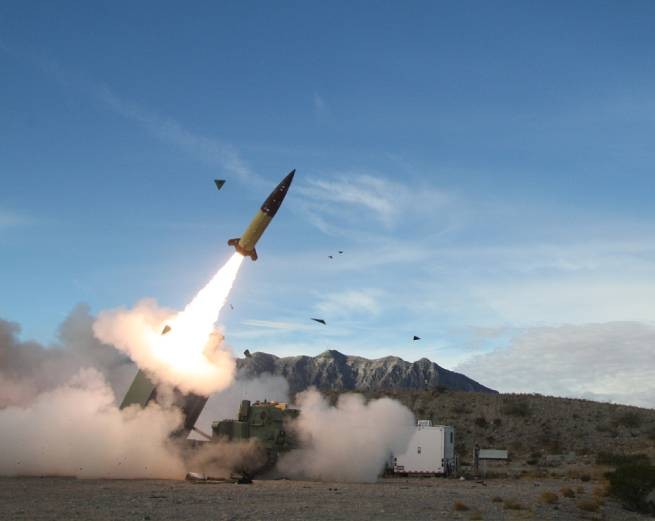ATACMS long-range missiles were used for the first time in Ukraine on April 17 – they were launched at the Dzhankoy airfield in Crimea, located 165 km from the Ukrainian front line.
How writes BB.LV US President Joe Biden's administration secretly sent missiles to Ukraine last month for the first time in the two-year military conflict, senior sources said, and Kyiv has twice already used the weapons to strike deep behind Russian lines.
The American resource Politico writes that additional US ATACMS long-range missiles will be included in the new military aid package approved by Biden. The award of ATACMS ends a long-running drama in which Ukraine has sought to obtain the weapons for years. The US secretly sent a version of the intermediate-range missile in October, but Ukraine continued to push for the transfer of weapons that would allow it to strike further behind Russian lines.
Ukrainian military forces have used long-range missiles twice, first against a Russian military base in Crimea and most recently against Russian troops east of Berdyansk, near the Sea of Azov, a senior US administration official said:
“There is no silver bullet that will change the nature of the battlefield. Ukraine has something in its arsenal that they can use at any time and place of their choosing that creates an effect that gives them an advantage.”
Long-range ATACMS allow Ukraine to threaten the Black Sea Fleet and Russian assets in Crimea. The weapons were part of a $300 million US aid package that President Joe Biden approved in March. Last Wednesday evening, US State Department spokesman Vedant Patel officially announced the supply of missiles:
“I can confirm that the United States provided Ukraine with ATACMS long-range missiles at the direct direction of the President. The missiles arrived in Ukraine in April.”
According to an anonymous Reuters source, the missiles were first used in the early morning of April 17 – launched at the airfield in Dzhankoy in Crimea, and strikes were also carried out against Russian troops in Ukrainian territory under their control. According to the New York Times, we are talking about a strike on Russian troops in occupied Berdyansk, Zaporozhye region. According to Patel, the US “did not initially announce this to ensure Ukraine's operational security at its request.”
It has not said exactly how many missiles have been delivered, but US administration national security adviser Jake Sullivan says Washington has provided a “substantial number” and plans to send more. “They will change the situation. But, as I said before, there is no magic wand,” he said.
He added that Ukraine promised to use missiles only for attacks within the occupied Ukrainian territories, and not across Russia. At the same time, British Admiral Sir Tony Radakin, in an interview with the business newspaper Financial Times, said that against the backdrop of new Western aid, Ukraine could increase long-range attacks deep in Russian territory. And he did not express obvious objections to this:
“As Ukraine gains more long-range combat capabilities … its ability to pursue deep operations will increasingly become a feature of the war.”
The US decision, writes the BBC, to supply Ukraine long-range ATACMS due to the fact that in December and January Russia used ballistic missiles supplied by North Korea, although the United States has repeatedly and publicly warned the Kremlin against such actions, Reuters writes, citing an American official. Another factor was Russian attacks on critical infrastructure in Ukraine. “We warned Russia about these things,” the official said. “But they resumed their attacks.”
US Department of Defense On April 24, it announced a $1 billion military aid package for Ukraine, the first since Congress passed additional funding to help foreign allies. The new package is the 56th that the Biden administration allocates under the PDA program, which provides for the supply of military aid directly from US military warehouses. Package includes:
- missiles RIM-7, AIM-9M,
- Stinger and Javelin anti-tank systems,
- shells of 155 mm (including cassette) and 105 mm caliber,
- shells for HIMARS systems,
- mortar mines of 60 mm caliber,
- anti-tank mines,
- Claymore anti-personnel mines,
- ammunition for clearing obstacles.
Among the equipment, the Pentagon lists Bradley infantry fighting vehicles, MRAP and Humvee armored vehicles, logistics support vehicles, tactical vehicles for towing and transporting equipment.
The message mentions small arms and additional ammunition for them, in particular for combating drones, “high-precision aviation ammunition,” airfield technical equipment, night vision devices, as well as spare parts and other auxiliary equipment. The Pentagon says:
“This package will increase the supply of ammunition, weapons and equipment to support Ukraine's ability to defend its front lines, defend its cities and resist persistent Russian attacks.”
https://www.youtube.com/watch?v=vhgAc4mz4O8







More Stories
The Russian Federation has put the Ukrainian president on the wanted list for an unnamed "Article of the Criminal Code"
Ombudsman: all orphans returned by Ukraine end up in families
Deputy Head of the Main Intelligence Directorate: "Such wars can only end with agreements"